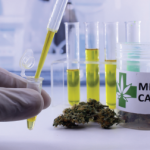
Brandon Crawford / shutterstock.com
Cannabis arteritis mirrors thromboangiitis obliterans in its clinical and arteriographic presentation, but its relevant exposure is cannabis rather than tobacco.1 Whether cannabis arteritis is a subset of thromboangiitis obliterans or a unique pathologic entity is debatable.
Delta-9-tetrahydrocannabinol, the primary psychoactive component of cannabis, is a peripheral vasoconstrictor.2 This offers mechanistic insight into how cannabis may cause the distal extremity ischemia characteristic of thromboangiitis obliterans. However, with rare exceptions, at least some tobacco use—concomitant with cannabis use—is reported in cases of cannabis arteritis.3,4
In the U.S., cannabis users infrequently mix loose tobacco with cannabis in a joint (i.e., cannabis rolled in cigarette paper) or pipe, as is typical in other countries.5 Yet almost two-thirds of cannabis users in the U.S. co-administer cannabis and tobacco at least occasionally as a blunt.5
Blunts are cigars or cigarillos that are hollowed out and filled with cannabis. A substantial minority of blunt smokers don’t consider themselves cigar or tobacco users.6 This has significant implications for obtaining the necessary social history in patients with a clinical presentation compatible with cannabis arteritis to reach the appropriate diagnosis, as demonstrated in this case.
Case Presentation
A 61-year-old man presented with a three-day history of diffuse swelling and pain in his right second finger. He had a three-month history of Raynaud’s phenomenon of the digits in both hands and a two-month history of progressively worsening, painful ulcerations of several distal fingertips. He had no inflammatory joint pain or swelling and no extremity numbness. He did not have fevers, weight loss, lymphadenopathy, dyspepsia, rashes or cutaneous nodules. He reported many months of dyspnea on exertion, and non-exertional, non-pleuritic substernal chest pain.
Whether cannabis arteritis is a subset of thromboangiitis obliterans or a unique pathologic entity is debatable.
His past medical history included hypertension and untreated hepatitis C. He had no known personal history of arterial or venous thrombosis. He was not taking any prescription medications, over-the-counter medications or supplements.
He smoked cannabis 8 to 10 times each week. He denied past or current tobacco use. He explicitly, and on multiple occasions, denied past or current smoking of cigarettes, cigars or pipes. He did not use any other drugs. He had no family history of autoimmune or metabolic diseases. He had never worked in an industrial factory.
Physical exam showed digital clubbing, with distal tuft swelling and tenderness of all distal fingertips. Dry ulcerations with a honey-colored crust were present on multiple fingertips, including the right second digit. This finger was diffusely swollen and tender. He could not flex the right second finger at the distal and proximal interphalangeal joints actively or passively due to severe pain. No sclerodactyly was present. The right third toe distal tuft was swollen, with a digital pit.



